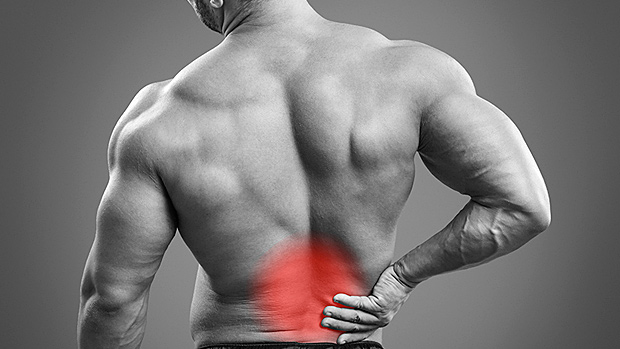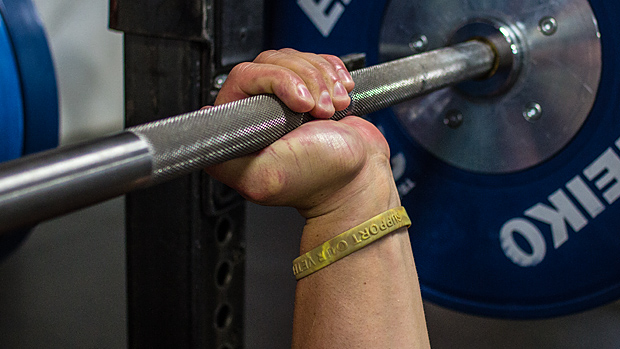Drop These Exercises
Few exercises are inherently dangerous, but if your posture sucks, then there are some that will be dangerous for YOU.
And it doesn't matter if you're not sedentary. Even athletes and committed lifters can learn the hard way that their posture isn't great. Luckily there are simple modifications you can make in order to train hard while protecting your orthopedic health.
Here are the three movements that can put your shoulders and spine at risk. I no longer program these for the majority of my athletes. The modifications they now use actually give them a greater training effect while minimizing joint stress.

Straight bar overhead pressing is one hell of a diagnostic tool. It'll tell you a lot about your spinal stability, scapular mobility, shoulder strength and function. But it's rarely a good fit for those struggling to achieve good positions.
First off, the symmetrical stance (feet parallel on the floor) has the potential to create instability and hyperextension at the lumbar-pelvic junction. It's this lack of trunk and pillar support that becomes the weakest link in the functional chain. It limits top-end loads and places unwanted stress on the spine.
Since the body is a functional unit, this hyperextension can become more notable when you lack the ability to achieve a neutral, or possibly even slightly extended, thoracic spine position. A rounded mid-back will be tough on the lower back and also on the shoulder, reducing space in the shoulder girdle for structures to properly function.
Between the lack of lumbar spine stability, thoracic spine mobility, and the ability to display functional range of motion and stability through the shoulder girdle, the overhead barbell press is risky.
Do This Instead: Dynamic Scrape-The-Rack Press
You might be familiar with this one. Coach Thibaudeau goes into detail with it HERE. It lessens all the problems that come with traditional overhead pressing, and it's become a staple pressing movement for my athletes.
Using a split stance will reduce the hyperextension of the lower spine and pelvis. Additionally, the friction between the bar and the rack increases the stability through the shoulders, and it increases the centration of the shoulder joint itself. This stimulates the intrinsic stabilizers of the gleno-humeral joint and scapula making everything work together better.
Finally, if you want to take this press to the next level, try using a false grip. This will reduce the carrying angle of the upper arm and position the shoulders in a more naturally centralized position. Again that means avoiding undue stress on these segments.
Since the anterior deltoid is largely comprised of fast twitch muscle fibers, train this movement explosively for low to moderate rep ranges. This will reduce the need to overload the movement.

Most lifters need to be doing horizontal pulls. These help ameliorate the affects of daily slumping and sitting. But the bent-over row isn't your best bet. There are better ways to develop a muscular posterior chain.
What makes it suck? The barbell bent-over row combines a high amount of requisite stability through the lower body, pelvis, and spine while simultaneously creating dynamic tension through the musculature of the back. So again it doesn't inherently suck for everyone but it might for YOU.
Even the more elite lifters and athletes that I evaluate can't hip hinge properly with their own bodyweight (the majority at least). So telling them to try and maintain a hip hinge isometrically, while powerfully lifting and lowering a heavy bar, is absurd.
If you lack the ability to do a proper hip hinge (a bow not a squat), this should automatically exclude you from the barbell bent-over row. It's a red flag that you shouldn't be getting in any bent-over position that also involves dynamic movement from the upper extremities.
You need the ability to maintain a neutral spine and pelvis in the hinge. The addition of an anteriorly loaded bar will create heavy compensation patterns. And when you're tasked with moving it up and down, your spine will move back and forth into flexion and extension, dumping the pelvis anteriorly and posteriorly during every rep. This is bad.
With a majority of the movement generated from joints and non-contractile structures, the poorly positioned bent-over row not only steals the muscular emphasis we're targeting, but places the body in a potentially injurious position, especially when training extended rep ranges and sets which involve cumulative postural fatigue.
Do This Instead: Chest-Supported Neutral Grip Row
For back development, use a chest-supported row. You'll get the same feel and training effect while keeping your spine neutral. By getting in a supported prone position on an incline bench, the isometric hip hinge is taken out of the equation. This shifts the emphasis on the muscles working to move the load.
Before you plop down on the bench and start rowing, tense the glutes, the lower extremities and the core to create a stable base. This should be easy since the spine and pelvis are neutral. Use a neutral grip with dumbbells. This hand and shoulder position is usually better tolerated than the pronated position required with the barbell.
Train this exercise in a variety of rep ranges and tempos. With the spine neutral, the shoulder centrated and stable, make this movement a back-friendly staple on your pulling days.

There's no exercise more notorious for messing up the shoulders than the upright row. And everybody knows it, which is why there are a dozen modifications in hand placement, bar path, and setup. They're all invented to make this exercise easier on the shoulder girdle. But why play with fire when there are safer alternatives that'll get you the same benefits?
The traditional upright row creates increased anteriorly-directed joint stress to the shoulder girdle, especially when shoulder mobility and thoracic spine positioning are less than perfect.
The lack of respectable posturing through the upper quadrant can create more of an internally rotated movement at the gleno-humeral joint, reducing the area of structures to freely slide and glide through. An imperfect posture can also keep the shoulder blades from functioning smoothly and synergistically against the thoracic cage.
This movement has a tendency to shift tension from the medial delts (which most lifters are attempting to target with this) to the upper traps. And that defeats the purpose because you can develop your upper traps in a gazillion more effective and less dangerous ways.
If your posture is dysfunctional don't even try to program modified versions of the upright row. The cost to benefit ratio is too small, even for athletes and lifters with great posture and healthy shoulders.
Do This Instead: Slight Bent-Over Dumbbell Lateral Raise
Emphasize strength and stability through the posterior shoulder girdle. Do this with a slightly bent-over dumbbell lateral raise. By bending the hips about 15 degrees or so, you can change the line of pull while also hitting more rear delt.
To keep these as pain-free as possible, pay attention to the height of the raise when you reach the top position (which should be parallel to the ground or slightly lower) and the position of the hands throughout the raise.
The internally rotated moment of the shoulders is a problem with the upright row, so avoid that same internally rotated position with lateral raise as well. Slightly externally rotate your shoulders and maintain this position throughout the get the most out of this variation with minimal joint stress.
How to Fix the Root Problem
These lifts will keep your shoulders and spine out of harm's way, but there's a big difference between training around piss-poor posture and working to remediate it so you can train without having to work around them.
I have a rule for my athletes: Every time that a compound movement needs to be modified, add another movement or two that will improve the position, posture, or region that's creating the dysfunction.
Think of programming the modified movement as a crutch that helps you walk without pain. You might get around fine with crutches, but is the goal to use crutches for the rest of your life, or to use them as a stepping stone to get back to walking?
The same can be said for modifications. If you have a crutch, also have a plan for eventually removing it. Here are two movements that will help to remediate poor posture and positions at the shoulders, spine, and ribcage. Work these into your dynamic warm-up anytime you use the above movements in training.
Lat & Thoracic Cage Mobility On Foam Roller
The foam roller stays still while you move. This creates leverage points mobilizing the thoracic cage and lats.
When there's poor posture at the shoulder girdle, the lats are usually involved. They have direct attachment points to the thoracic cage and spine, and they also insert onto the humerus. Tight lats can cause thoracic spine rounding and an overly internally-rotated shoulder position.
Do this drill with smooth and coordinated movements in and out of end range to mobilize these major segments together to rid your body of poor posture and dysfunction.
Side-Lying Thoracic Spine Rotation With Arm Reach
Try this one after you've done the first drill. It's a staple for opening up the chronically tight pecs while also incorporating a strong and stable hip, pelvic, and lumber spine position to create a steady base.
Many times when an athlete lacks proper thoracic spine rotation, scapular dynamic stability, and shoulder range of motion, it's more so a coordination issue than mobility issue. This drill will challenge you to move well in order to progress, which is great for creating serious results that will transfer back into your training.
Start with a few rounds of 10-15 reps per side with slow and deliberate form.





